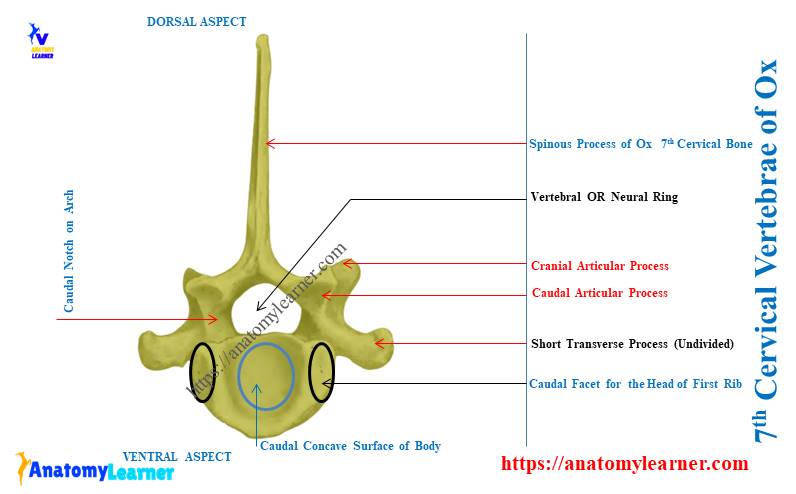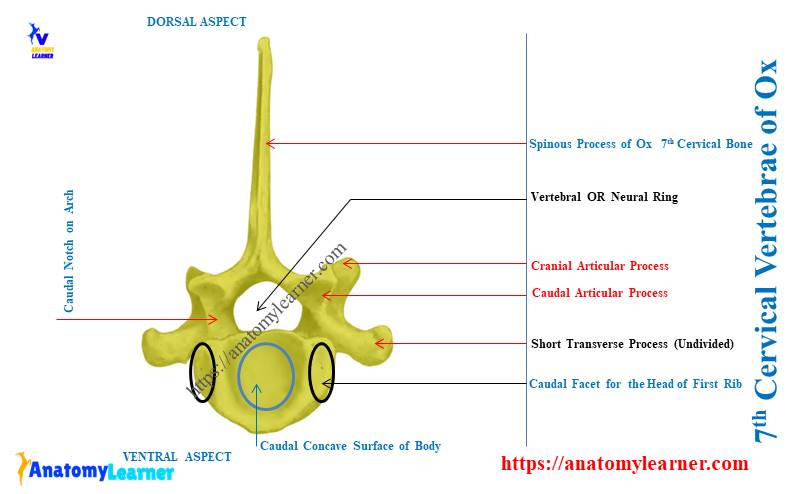The 7th cervical vertebrae of an ox are the last bone of the neck. It articulates cranially with the caudal part of the 6th and caudally with the 1st thoracic vertebrae.
Here, I will show the typical features of the 7th cervical vertebra from the ox neck. You will learn why an ox’s seventh cervical vertebra is unique to other vertebrae of this series.
The seventh cervical vertebrae of an ox have two caudal pair facets on its body. These facets articulate with the head of the first pairs of ribs. The foramen transversarium is absent, and the spinous process is flat and well-developed.
If you want to know these unique features of the seventh cervical vertebra of an ox in detail, let’s continue this article.
7th cervical vertebrae of ox
The 7th cervical vertebrae of ox possess almost typical features of third, fourth, and fifth cervical vertebrae. But, it shows the little different features on the caudal part of the body, notches on arches, transverse foramen, and processes.
Let’s identify the below-mentioned unique osteological features from the 7th cervical vertebra of the ox –
- A short and caudally wider body of the 7th cervical vertebra,
- Caudal pair of facets on the dorsal aspect of the body,
- Larger caudal notches on the pedicle of the 7th cervical vertebra,
- Longer cranial pair of articular processes with surfaces,
- Short caudal pair of articular processes of 7th cervical vertebra,
- Well-developed spinous process,
- Undivided transverse processes on both lateral aspects, and
- Ventral crest or tubercles on the body of the 7th cervical vertebra,
All these unique facts from the seventh cervical vertebra of an ox are identified in the labeled diagram. I hope you will now understand the unique facts of this vertebral bone.

Unique features of the 7th cervical vertebra of ox
Let’s enlist unique osteological features from the seventh cervical vertebra of an ox –
- #1. The dorsoventral flattened and wide caudal part of the body possesses exceptional one pair of facets for the first pair of ribs,
- #2. Caudal notches on the pedicle are larger in the seventh cervical vertebra,
- #3. The cranial articular process is longer and wider in the 7th cervical vertebra than the caudal articular process,
- #4. A well-developed and undivided transverse process is present in the structure of the 7th cervical vertebra,
- #5. You will not find any transverse foramen (foramen transversarium) in the structure of the 7th cervical vertebra,
- #6. A pair of tubercles sometimes replace the ventral crest of the body,
So, above these are the unique osteological facts for the seventh cervical vertebra of an ox that made them different from others.
But, it will be better if you have an idea of the typical features of a vertebra. That might help you to understand the unique features of the 7th cervical compared to the typical vertebra.
You may read the below-mentioned article to get the ideal features of a vertebra –
7th cervical vertebrae of ox anatomy
In the anatomy of the 7th cervical vertebra of an ox, you might describe the followings –
- #1. Structure of the body of the seventh cervical vertebra,
- #2. Osteological features of the 7th cervical bone, and
- #3. Features of the three different processes from the 7th cervical vertebra,
First, let’s see the osteological features of the seventh cervical vertebra of the ox.
Body of the seventh cervical vertebra
The body of the seventh (7th) cervical vertebra of an ox is comparatively short and wide than other bones of this series. You will see the dorsoventrally flattened and narrow body in its cranial segment.
But, the caudal segment of the body is wider than the cranial segment.
The cranial extremity of the seventh cervical vertebrae is convex and articulate with the body of 6th cervical vertebra. Again, the caudal end of the body is concave like other cervical vertebrae.
The body also shows the dorsal and ventral surfaces. Here, the ventral crest of the ox seventh cervical vertebra’s body is replaced by the pair of tubercles.
The wide and flattened dorsal surface of the body forms the floor of the neural ring. Again, on the dorsal surface of the body of the seventh cervical vertebra, the arches arise on both sides.
Unique features of the 7th cervical vertebra’s body
The caudal extremity of the 7th cervical vertebra’s body presents one pair of facets. This facet locates at the dorsal aspect of the caudal end of the body.
These are the fovea costalis caudalis and articulates with part of the head of the first rib. But, the costal fecets on the cranial end of the first thoracic vertebra also form the articular surface for the first pair of ribs.
You may know the structure of the rib’s head and tubercle from the below-mentioned article of anatomy learner –
From this article, you will also know – how the head and tubercle of the first rib articulate with the body of the 7th cervical vertebra.
Arches of 7th cervical vertebrae of ox
You may still identify the arches (pedicles and laminae) from the 7th cervical vertebrae of the ox. The pedicles of this cervical vertebra show larger notches on both sides.
But, the caudal notches on the arches are comparatively larger than the cranial notches.
The lamina of the 7th cervical vertebra is a thin plate-like structure. Here, the right and left laminae of the seventh cervical vertebra join at the midline and form the spinous process.
Processes of the seventh cervical vertebra
This seventh cervical vertebra of an ox shows both cranial and caudal articular processes. The cranial articular process of the 7th cervical bone is comparatively larger (wider and longer) than the caudal articular process.
You will see the longer and well-developed spinous process in the structure of the seventh cervical vertebra. It looks like the spinous process of a first thoracic vertebra.
But what is the most unique feature of the transverse process (TP) of the seventh cervical vertebra? The transverse process of this vertebra is undivided. Again, there is no foramen transversarium (transverse foramen) within the structure of a transverse process.
Seventh cervical vertebra of ox diagram
Now, let’s see the various labeled diagrams on the seventh cervical vertebrae of an ox. The body, arches, and processes are identified in the 7th cervical vertebra labeled diagram.
The diagram shows only a single undivided transverse process (with no transverse foramen). Again, the diagram identifies the long spinous process from the seventh cervical vertebra.
The labeled diagram also identifies the exceptional caudal facets of the rib’s head. An articular surface that is made by the seventh cervical and first thoracic vertebrae for ribs is also shown in the diagram.
Let’s find more labeled diagrams on the 7th cervical vertebra on social media of anatomy learners.
How to differentiate the 7th cervical vertebra of an ox from the 6th cervical bone?
You may easily differentiate the 7th cervical vertebra from the 6th cervical vertebra by the appearance of their transverse process and body. The transverse process of the 7th cervical bone is undivided, whereas it is divided into 2 segments in the 6th cervical vertebra.
Again, the body of the 7th cervical bone possesses caudal pair facets, but the 6th cervical bone has no such feature. The spinous process of the 7th cervical bone is larger than the 6th cervical vertebra.
Let’s see the major differentiating points between the 7th and 6th cervical bones of the ox neck from Table 1 –
| Features | 7th cervical vertebra of ox | 6th cervical vertebra of ox |
| Body | Long Wide | Wider Dorsoventrally flattened |
| Caudal facets | Present caudally | No facets on body |
| Articular process | Less developed | Well-developed |
| Spinous process | Longer | Shorter |
| Transverse process | Undivided | Divided Dorsal and ventral parts |
| Transverse foramen | Absent | Larger |
How many cervical vertebrae does an ox have?
Quick answer: an ox has 7 (seven) cervical vertebrae. You will see the modification in the structure of the first, second, sixth, and seventh cervical vertebrae of an ox.
The third, fourth, and fifth (3rd, 4th, 5th) cervical vertebrae are typical in the ox’s neck. In the typical vertebra structure, you will find the cylindrical body, arches on both right and left lateral aspects and three major processes.
What animal have 7 cervical vertebrae?
Quick answer: most domestic and companion animals have 7 cervical vertebrae. You will find 7 cervical vertebral bones in cows, horses, dogs, cats, goats, and sheep.
What is the vertebral formula of an ox?
Quick answer: the vertebral formula of the ox is C7 T13 L6 S5 C18 – 21. Here, C = Cervical vertebrae, T = Thoracic vertebrae, L = Lumbar vertebrae, S = Sacral vertebrae, and C = Coccygeal or caudal vertebrae.
So, there are 7 cervical, 13 thoracic, 6 lumbar, 5 sacral, and 18 – 21 caudal vertebrae in the spine of ox.
Conclusion
So, the 7th cervical vertebrae of an ox have a short body, arches, and processes. The most important feature of the seventh cervical vertebra is the presence of caudal pair facets on its body.
The provided anatomical facts of the 7th cervical vertebra of an ox might help you to identify and differentiate it from other vertebrae.

